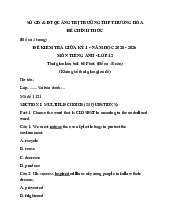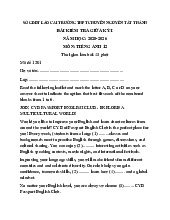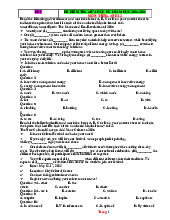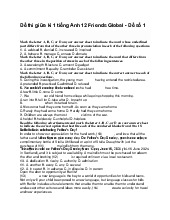





Preview text:
ĐỀ CƯƠNG ÔN TẬP KIỂM TRA GIỮA HỌC KÌ I
Môn: Tiếng Anh ( khối 12)
Năm học 2025-2026
I. TOPICS: (UNIT 1 + UNIT 2) • Life stories we admire • A multicultural world II. GRAMMAR:
• Past simple and Past continuous
• Definite and indefinite articles
III. TYPES OF QUESTIONS:
1. Complete the announcement: 6 questions
2. Complete the advertisement : 6 questions
3. Reorder the Dialogue / Letter / Paragraph: 5 questions
4. Fill in the Missing Information : 5 questions
5. Reading Comprehension: 8 Questions
6. Reading Comprehension: 10 Questions
ĐỀ THAM KHẢO SỐ 1
Read the following advertisement and mark the letter A, B, C or D on your answer sheet to indicate
the option that best fits each of the numbered blanks from 1 to 6.
Explore a Rich Cultural Journey!
Are you interested in exploring diverse traditions from around the world? Our (1) _______ offers an
(2) _______ journey, bringing you closer to local heritage and authentic experiences. (3) _______ part
in this enriching adventure will deepen your understanding of global cultures!
Led by experienced local guides, our tours offer you the chance (4) _______ with communities,
participating in traditional festivals and learning ancient customs. With memorable activities, you‟ll
visit iconic cultural landmarks, taste traditional cuisine, and discover the beauty of regional arts, (5)
_______ you a deeper connection to the local culture.
Ready to take your curiosity to new heights? Join us today to begin your cultural adventure, and let the
world‟s wonders unfold before you. Whether you‟re passionate (6) _______ history, art, or folklore,
our tour will leave you inspired and enriched.
Question 1: A. unique cultural program tour
B. program unique cultural tour
C. unique cultural tour program
D. tour programs cultural unique
Question 2: A. impressively B. impression C. impressive D. impress
Question 3: A. Making B. Doing C. Paying D. Taking
Question 4: A. to engaging B. to engage C. engaging D. engage
Question 5: A. that give B. which giving C. giving D. gave
Question 6: A. in B. about C. on D. by
Read the following leaflet and mark the letter A, B, C, or D on your answer sheet to indicate the
correct option that best fits each of the numbered blanks from 7 to 12.
THOMAS EDISON: THE WIZARD OF MENLO PARK
Thomas Edison was a pioneering inventor and businessman who grabbed the (7) _______ for his
contributions to the development of electric light and power systems. He made significant Trang 1
advancements in technology, earning the title of “The Wizard of Menlo Park.” Edison aimed to (8)
_______ the world with his innovative inventions.
Early Life & Family
Born on February 11, 1847, in Milan, Ohio, Edison was the youngest of seven children. His mother, a
former school teacher, educated him at home after he struggled in school. After that, (9) _______ his
ambitions, he developed a keen (10) _______ in science and technology. Legacy
Edison‟s impact on technology and industry is (11) _______. He is often credited with creating the
first industrial research laboratory, which revolutionized how inventions are developed. Today, he is
remembered as one of history‟s greatest inventors, whose work influences (12) _______ and reshapes the future.
(Adapted from Asian Scientist)
Question 7: A. labels B. titles C. headlines D. captions
Question 8: A. catch up with B. light up C. carry out D. calm down
Question 9: A. On behalf of B. Instead of C. Because of D. In case of
Question 10: A. comfort B. interest C. ease D. leisure
Question 11: A. immeasurable B. trivial C. insignificant D. glamorous
Question 12: A. other B. another C. others D. the others
Mark the letter A, B, C, or D on your answer sheet to indicate the best arrangement of utterances or
sentences to make a meaningful exchange or text in each of the following questions from 13 to 17. Question 13:
a. Alex: Been there, done that! Tell you what - I picked up some awesome time management hacks that are total game-changers.
b. Maya: Ugh, I‟m just swamped with this work-life balance thing. Feels like I‟m running on empty.
c. Alex: Hey, what‟s eating you? You‟ve been super stressed out lately. A. b-a-c B. b-c-a C. c-b-a D. a-c-b Question 14:
a. Jake: Right? And get this - they‟ve got these AI systems running the whole show.
b. Rachel: No way! I‟m so over-sitting in traffic. This sounds like a total dream.
c. Jake: Yo, check this out! They‟re building this crazy smart city with self-driving everything!
d. Rachel: For real? But doesn‟t that freak you out a bit? Like, what if the system crashes?
e. Jake: Nah, that‟s the beauty of it – they‟ve got all these fail-safes. It‟s pretty mind-blowing stuff. A. c-a-b-d-e B. c-b-a-d-e C. c-d-a-b-e D. c-b-e-a-d Question 15: Dear Jamie,
a. You wouldn‟t believe how locals have adapted their traditional businesses to cater to this new crowd.
b. Every corner has these cool co-working spaces packed with people from all over the globe.
c. It‟s fascinating to see ancient culture and modern technology existing in perfect harmony.
d. The whole digital nomad scene here in Bali has completely transformed how people experience travel.
e. You should definitely check it out – it might change your perspective on remote work altogether. Best wishes, Sam A. d-a-c-b-e B. d-b-c-a-e C. d-a-c-d-e D. d-b-a-c-e Question 16:
a. Unlike my previous corporate job, there were no traditional hierarchies or fixed departments here.
b. Instead, I found myself collaborating with different teams based on project needs and expertise.
c. During my first week at a modern startup, I was amazed by their unique approach to team structure.
d. Looking back, I realize this experience completely changed my view of organizational management. Trang 2
e. This flexible system not only boosted our creativity but also made work more engaging and meaningful. A. c-a-b-d-e B. b-c-a-e-d C. c-a-e-b-d D. c-d-e-b-a Question 17:
a. The invention quickly transformed cities, extending human activity well into the night hours.
b. When Thomas Edison first unveiled his electric light bulb in 1879, few could imagine its impact.
c. Factories could now operate around the clock, revolutionizing industrial production worldwide.
d. This simple innovation sparked numerous related inventions in power distribution and electronics.
e. Today, we‟re witnessing similar revolutionary changes with artificial intelligence and quantum computing. A. b-a-c-d-e B. b-a-d-c-e C. c-b-a-e-d D. c-d-e-b-a
Read the following passage about Trịnh Công Sơn, a famous Vietnamese musician, and mark the
letter A, B, C or D on your answer sheet to indicate the option that best fits each of the numbered
blanks from 18 to 22.
Trịnh Công Sơn, born in 1939 in Đắk Lắk Province, Vietnam, became one of the country‟s most
beloved singer-songwriters. Sơn, with great efforts, (18) _______.
Despite initially studying to become a teacher, Sơn found his true calling in music. He began
composing in the 1950s with a number of wonderful songs (19) _______. His songs gained popularity
in the 1960s and 1970s, a tumultuous period in Vietnamese history.
(20) _______. Specifically, his compositions like “Nối vòng tay lớn” (The Great Circle of
Vietnam) became anthems for peace during the Vietnam War era. Sơn‟s music spoke to the
experiences and emotions of the Vietnamese people during this challenging time.
His music transcended political boundaries, touching lives across Vietnam and beyond. His concerts
were major events, drawing thousands of fans who were moved by his soulful performances and
meaningful lyrics. Moreover, resonating deeply with audiences, (21) _______.
After Vietnam‟s reunification, (22) _______. He remained an active and influential figure in the
Vietnamese music scene until his passing in 2001, leaving behind a rich legacy of over 600 songs that
continue to be cherished and performed by artists in Vietnam and around the world.
(Adapted from https://en.wikipedia.org) Question 18:
A. of whom poetic lyrics and haunting melodies were known as the "Bob Dylan of Vietnam"
B. as the "Bob Dylan of Vietnam" known for his poetic lyrics and haunting melodies
C. became known as the "Bob Dylan of Vietnam" for his poetic lyrics and haunting melodies
D. becoming "Bob Dylan of Vietnam" known for his poetic lyrics and haunting melodies Question 19:
A. of which blended approach to lyrics and melodies have given rise to timeless classics
B. attracted listeners with lyrics and melodies that contributed to timeless classics
C. approached to lyrics and melodies in order to be acknowledged as timeless classics D. whose blended
approach to lyrics and melodies in shaping timeless classics Question 20:
A. Sơn was recognized for capturing the spirit of the war years through his artistic expression
B. Artists in the realms of poetry, music, and social reflection in the war years contributed to Sơn‟s impact
C. Aiming to resonate with the masses through song, Sơn‟s songs evolved as a cultural icon in the war years
D. The fusion of poetic simplicity and national, social awareness in the war years shapes Sơn‟s influence Question 21:
A. a sense of community and connection was encouraged
B. Sơn could make his artistry foster community connection
C. his artistry fostered a sense of community and connection
D. enhancing community connection was Sơn‟s intention Question 22: Trang 3
A. by channeling societal sentiments into his music, it couldn‟t reflect the changing times
B. integrating societal sentiments into his music, they helped him reflect on the changing times
C. he channeled societal sentiments into his music, reflecting the changing times
D. reflecting the changing times through his music, societal sentiments were channeled
Read the following passage and mark the letter A, B, C or D on your answer sheet to indicate the
option that best fits each of the numbered blanks from 23 to 30.
Inside a dimly lit warehouse in Brooklyn, vintage arcade machines illuminate rows of eager visitors
with their neon glow. Weekly attendance at Retro Gaming Haven has quadrupled since its opening last
spring, reflecting a broader cultural phenomenon. As economic uncertainty looms, consumer spending
on nostalgic entertainment and memorabilia continues to surge across demographics.
Market analysis from the Consumer Behavior Institute shows unprecedented growth in memory-
centric industries. Vinyl record sales have climbed 80% annually, while retro gaming platforms thrive
through archived content. Contemporary audiences gravitate toward past-era entertainment, as it
evokes emotional resonance through shared cultural touchstones. Digital platforms curating vintage
content report viewer retention rates 35% higher than modern entertainment channels, highlighting a
significant shift in consumption patterns across various age groups and social demographics.
Research by Social Psychology Quarterly shows nostalgia-driven consumption intensifies during
social change periods. Consumers direct significant entertainment spending toward reimagined
cultural artifacts. Visual aesthetics from previous decades permeate contemporary design, garnering
particular appeal among young professionals. Studies show audiences engage more deeply with
content invoking collective memory, spending 45% more time with vintage-inspired media formats
across multiple platforms and entertainment categories, from streaming services to interactive experiences.
In response, entertainment conglomerates reshape marketing around memory-driven experiences.
Production studios amalgamate period-specific elements into contemporary offerings while streaming
platforms spotlight archived content through recommendation algorithms. Industry metrics show that
vintage-inspired content maintains strong viewer engagement across demographics. Cultural analysts
observe how retrospective entertainment elements crystallize community connections through shared
historical references, fostering social cohesion. Memory-centric programming drives robust discussion
in digital forums, where audiences examine cultural significance through modern perspectives and
shared experiences, creating lasting connections between past and present entertainment forms while
building bridges across different consumer segments.
(Adapted from Digital Entertainment Weekly)
Question 23: Which of the following is NOT mentioned as a benefit of nostalgic content?
A. emotional connection B. viewer retention C. educational value D. social bonding
Question 24: The word “it” in paragraph 2 refers to ______. A. emotional resonance
B. past-era entertainment C. archived content D. vinyl record
Question 25: Which of the following best paraphrases the underlined sentence in paragraph 3?
A. Modern audiences pour substantial financial resources into entertainment that reinterprets classic elements.
B. The entertainment market thrives when cultural pieces from the past return with fresh perspectives.
C. Among various spending choices, revamped nostalgic content attracts respectable portions of consumer budgets.
D. Cultural products that blend historical roots with new forms command impressive consumer expenditure.
Question 26: The word “amalgamate” in paragraph 4 is OPPOSITE in meaning to ______. A. bifurcate B. segregate C. dislodge D. disengage
Question 27: The word “robust” in paragraph 4 could best be replaced by ______. A. resilient B. vigorous C. sturdy D. tough
Question 28: Which of the following is TRUE according to the passage?
A. Modern entertainment platforms incorporate nostalgic elements to sustain audience participation.
B. Audiences display heightened responsiveness to memory-based content in digital spaces. Trang 4
C. The fusion of historical references with modern formats shapes collective viewing experiences.
D. Archived content emerges as a catalyst for meaningful social bonds among diverse consumers.
Question 29: In which paragraph does the writer examine the relationship between social change and consumer spending patterns? A. Paragraph 1 B. Paragraph 2 C. Paragraph 3 D. Paragraph 4
Question 30: In which paragraph does the writer explore content curation strategies? A. Paragraph 1 B. Paragraph 2 C. Paragraph 3 D. Paragraph 4
Read the following passage about the urban shift and mark the letter A, B, C or D on your answer
sheet to indicate the best answer to each of the following questions from 31 to 40.
„Ao dai‟ is widely recognized as the Vietnamese costume. It depicts not just Vietnamese attire
and communication culture, but also Vietnamese women‟s souls and personalities. [I] Although
national customs have evolved throughout the years, they still serve as a baseline of elegance and refinement [II].
As a result, many female foreigners in Da Nang, and throughout Vietnam, wish to have their
own „Ao dai‟ tailored. However, they do not want to wait many days, if not a week, for such fine
apparel at large tailor shops. [III] Tailors in Han Market are now offering one-hour tailoring services to
meet the demand of international tourists, particularly those visiting the city on pre-booked excursions.
Visitors can wait or wander the market for an hour after obtaining such services to pick up their
personalized ‘Ao dai’. [IV]
Currently, the Han Market is home to over 200 tailoring shops offering such services. Ms Tran
Thuy Kieu, the owner of the Kieu Tailor Shop in the Han Market, stated that during the peak tourist
season of April to August, she customized between 30 and 40 „ao dais‟ each day. The tailoring cost is
320,000 VND per youngster and 350,000 VND per adult. She noted that the majority of her customers
were from South Korea, and they chose dark blue or black „ao dai‟ cloth with hand embroidery designs.
Ms Nguyen Thi Thanh Van, Head of the Market's Management Board, stated that the
development of the one-hour tailoring service demonstrates local tailors' active efforts to meet the
surging expectations of foreign visitors visiting in the city. She also emphasized the importance of this
service in improving wages for local tailors, making the Han Market more appealing to foreign
visitors, and promoting Vietnam's traditional cultural values.
(Adapted from https://vietnam.travel/)
Question 31: Where in this passage does the following sentence best fit?
'Ao dai' is a symbol of traditional Vietnamese female beauty and a source of national pride. A. [I] B. [II] C. [III] D. [IV]
Question 32: The word appealing to in paragraph 4 could be best replaced by ______. A. detrimental to B. indifferent to C. similar to D. attractive to
Question 33: The word their in paragraph 2 refers to ______. A. female foreigners B. 'Ao dai'
C. international tourists D. tailor shops
Question 34: According to paragraph 3, which of the following statements is NOT true about Ms. Tran Thuy Kieu's customers?
A. They often choose dark blue or black fabric for their ao dai.
B. They prefer ao dai with hand embroidery designs.
C. The majority of her customers come from South Korea.
D. They usually select vibrant colors for their ao dai.
Question 35: Which of the following best summarises paragraph 4?
A. Local tailors have created a one-hour tailoring service to cater to foreign visitors, improving both wages and market appeal.
B. The one-hour tailoring service is primarily focused on promoting Vietnam's cultural values. C. Ms.
Nguyen Thi Thanh Van highlights the importance of the one-hour tailoring service for promoting cultural values.
D. The one-hour tailoring service addresses increasing demands from tourists and fosters local cultural pride. Trang 5
Question 36: The word surging in paragraph 4 is OPPOSITE in meaning to ______. A. emerging B. diminishing C. ascending D. spiraling
Question 37: Which of the following is TRUE according to the passage?
A. Tailors in Han Market do not offer any services for international tourists.
B. Despite the fact that national traditions have changed over time, they no longer represent a standard of grace and sophistication.
C. Less than 30 'ao dais' are customized daily during the busiest travel season, according to Ms. Tran Thuy Kieu.
D. Customized ao dai without lengthy wait times is what many international women in Da Nang desire.
Question 38: Which of the following best paraphrases the sentence in paragraph 2?
A. After receiving their ao dai, visitors have an hour to explore the market.
B. Visitors can explore the market for an hour while waiting for their ao dai to be completed.
C. Before ordering their ao dai, visitors can leave and return later.
D. Visitors need to stay close to the tailor shop until their ao dai is ready.
Question 39: Which of the following can be inferred from the passage?
A. Foreign tourists are the main consumers of Vietnamese fashion.
B. Tailors in Vietnam are adapting to meet the needs of international visitors.
C. The ao dai is losing its significance in Vietnamese culture.
D. Foreign tourists prefer traditional clothing to modern apparel.
Question 40: Which of the following best summarises the passage?
A. The demand for 'ao dai' has decreased due to the rise of Western clothing styles in Vietnam.
B. Tailoring services in Vietnam have improved, attracting mostly local customers interested in 'ao dai'.
C. 'Ao dai' is a cultural symbol, and fast tailoring services are very enticing to international visitors.
D. The Han Market has become a popular destination for tourists seeking personalized ao dais within an hour. - THE END - Trang 6



